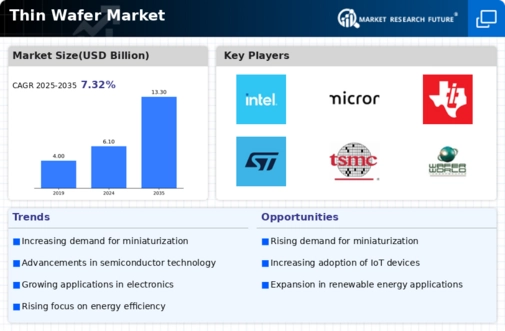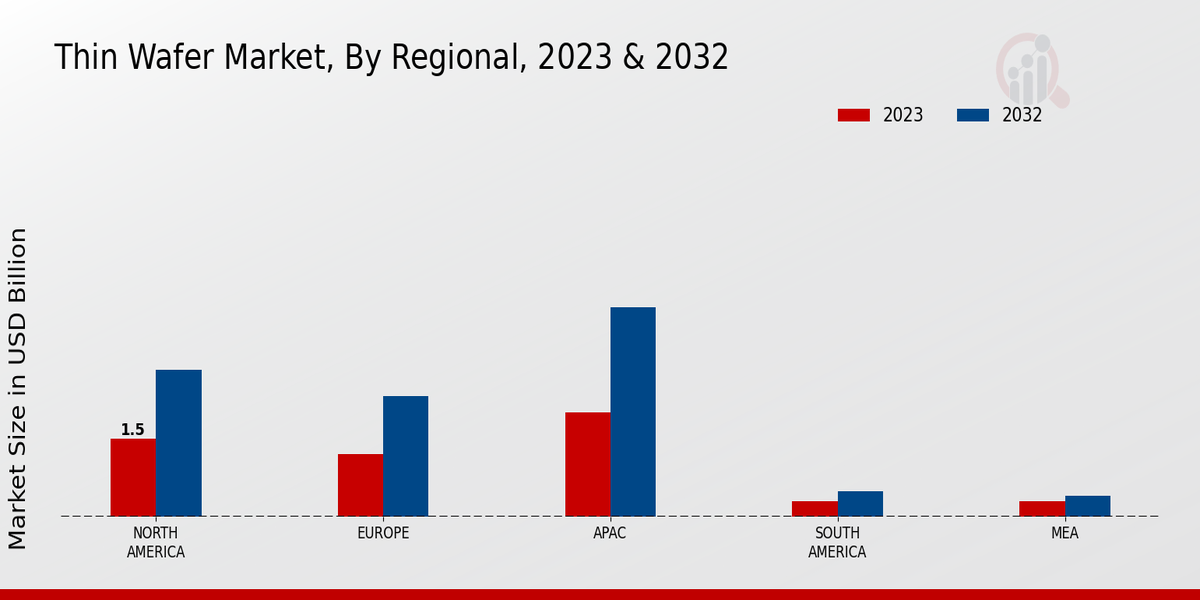Market Growth Projections
The Global Thin Wafer Market Industry is poised for substantial growth, with projections indicating a market value of 6.1 USD Billion in 2024 and an anticipated increase to 13.3 USD Billion by 2035. This growth trajectory reflects a compound annual growth rate (CAGR) of 7.33% from 2025 to 2035. Such figures suggest a robust demand for thin wafers across various sectors, driven by technological advancements and evolving consumer preferences. The market's expansion is likely to be fueled by the increasing integration of thin wafers in diverse applications, ranging from consumer electronics to renewable energy technologies. This upward trend underscores the importance of thin wafers in shaping the future of multiple industries.
Increased Focus on Energy Efficiency
The Global Thin Wafer Market Industry is significantly influenced by the growing emphasis on energy efficiency across various sectors. As industries strive to reduce their carbon footprint and operational costs, the demand for energy-efficient solutions has surged. Thin wafers, known for their superior performance and reduced energy consumption, are increasingly being adopted in applications ranging from renewable energy systems to electric vehicles. This trend aligns with global sustainability goals and is expected to drive market growth. The anticipated CAGR of 7.33% from 2025 to 2035 highlights the potential for thin wafers to play a crucial role in achieving energy efficiency targets.
Growing Demand for Consumer Electronics
The Global Thin Wafer Market Industry experiences a surge in demand driven by the proliferation of consumer electronics. As devices such as smartphones, tablets, and wearables become increasingly sophisticated, the need for thinner and more efficient wafers intensifies. In 2024, the market is projected to reach 6.1 USD Billion, reflecting the industry's adaptation to consumer preferences for lightweight and compact devices. This trend is likely to continue as manufacturers seek to enhance performance while minimizing size, thereby propelling the growth of the thin wafer segment. The increasing integration of advanced technologies in consumer electronics further underscores the importance of thin wafers in meeting market expectations.
Advancements in Semiconductor Technology
Technological advancements in semiconductor manufacturing play a pivotal role in the Global Thin Wafer Market Industry. Innovations such as 3D integration and advanced packaging techniques necessitate the use of thinner wafers to optimize performance and efficiency. These advancements not only enhance the functionality of electronic devices but also contribute to cost reductions in production. As the industry evolves, the demand for thinner wafers is expected to rise, with projections indicating a market value of 13.3 USD Billion by 2035. This growth is indicative of the ongoing transformation within the semiconductor landscape, where thin wafers are becoming integral to next-generation applications.
Emerging Applications in Automotive Sector
The Global Thin Wafer Market Industry is witnessing emerging applications within the automotive sector, particularly with the rise of electric vehicles (EVs) and advanced driver-assistance systems (ADAS). Thin wafers are essential for the miniaturization of electronic components, enabling the integration of sophisticated technologies in vehicles. As the automotive industry increasingly adopts smart technologies, the demand for thin wafers is likely to grow. This trend not only enhances vehicle performance but also aligns with the industry's shift towards electrification and automation. The potential for thin wafers to revolutionize automotive applications indicates a promising avenue for market expansion.
Expansion of Renewable Energy Technologies
The expansion of renewable energy technologies is a significant driver for the Global Thin Wafer Market Industry. As governments and organizations worldwide invest in sustainable energy solutions, the demand for thin wafers in solar cells and other renewable energy applications is on the rise. Thin wafers facilitate higher efficiency rates and lower production costs, making them an attractive choice for manufacturers in the renewable sector. This trend is expected to contribute to the market's growth trajectory, with projections indicating a robust increase in demand as the world transitions towards cleaner energy sources. The integration of thin wafers into renewable technologies underscores their importance in the global energy landscape.













